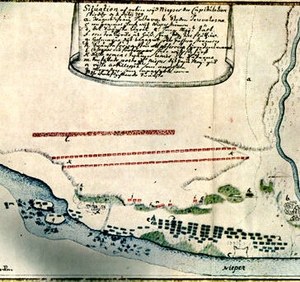Surrender at Perevolochna
| Perevolochna | |||||||
|---|---|---|---|---|---|---|---|
| Part of Great Northern War | |||||||
 Map depicting the surrender. Red=Russians and blue=Swedes. In the bottom left, Charles XII crosses the Dnieper along the two islands. Perovolocna is to the right, next to the Vorskla River. |
|||||||
|
|||||||
| Belligerents | |||||||
|
|
|
||||||
| Commanders and leaders | |||||||
| Adam Ludwig Lewenhaupt (POW) | Alexander Menshikov | ||||||
| Strength | |||||||
| 12,000 | 9,000 | ||||||
| Casualties and losses | |||||||
| 20,000 captured | |||||||
The surrender at Perevolochna was the capitulation of almost the entire Swedish army on June 30, 1709 (O.S.) / July 1, 1709 (Swedish calendar) / July 11, 1709 (N.S.). It signified the annihilation of the once formidable Swedish army after the defeat at Battle of Poltava, and paved the way for the eventual Russian victory in the Great Northern War. After the Battle of Poltava, Charles XII escapes to Turkish Moldavia.
Leaving Pushkaryovka around 7 PM on the 28th, the same day as their defeat, the remnants of the Swedish army head south following the west bank of the Vorskla River to the Dnieper River, reaching Starie Senzhary 20 km to the south where the baggage wagons stopped until dawn while the artillery, treasure-wagons and troops continue on to Novie Senzhary. The artillery reached Novie Senzhary after midnight, Charles XII at 1:30 AM, and the troops at dawn. The Tsar Peter the Great sent Prince Golitzine's Semyonovskiy Regiment and Bauer's ten regiments of dragoons in pursuit.
The march resumed by 7 AM on the 29th, heading for Bjeliki, and Major-General Meijerfelt is sent back to negotiate with the Tsar. The convoy linked up with Lt. Col. Silfverhielm's 500 men at Kobelyaki in the late afternoon. On 30 June, the convoy reached Tashtayka on the Dnieper where Axel Gyllenkrok had been sent earlier to prepare a crossing. However, Gyllenkrok wanted Charles to stop at Kishenka, and decide if they should cross the Vorskla at the ford and head into the Crimea, or head further south and attempt a crossing of the Dnieper into Turkey. Now the Swedes found the Dnieper river broad and swift, with few materials with which to build boats or a bridge.Ivan Mazepa and his men along with Silfverhielm's men crossed on the few boats available. Efforts to swim across ended in drowning for men and horse alike.
...
Wikipedia
